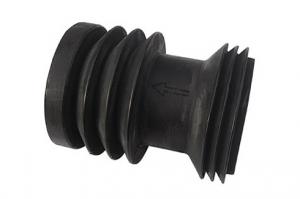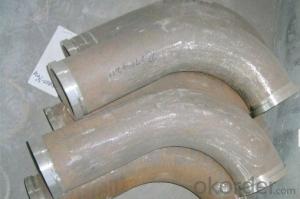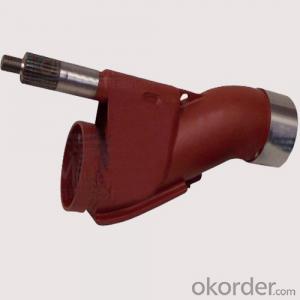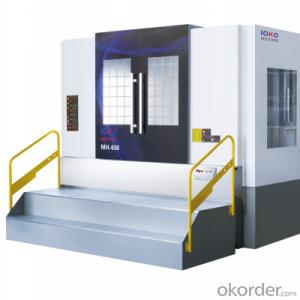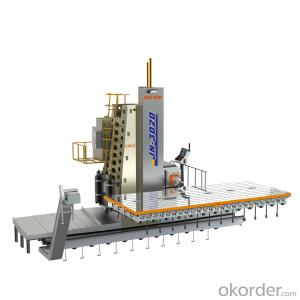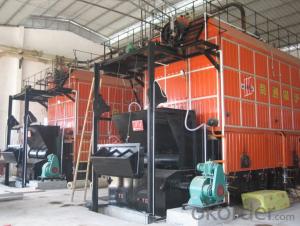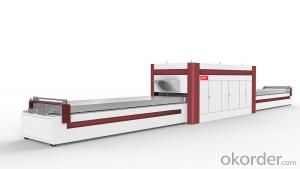Forged Wedge Coupling DN 125 with Hgh quality
- Loading Port:
- Tianjin
- Payment Terms:
- TT or LC
- Min Order Qty:
- 5 pc
- Supply Capability:
- 1000 pc/month
OKorder Service Pledge
OKorder Financial Service
You Might Also Like
Product Description:
Name:Forged Wedge Coupling DN 125 with Hgh quality
Type: Snap coupling, Bolt coupling, Wedge Coupling, adjustable or mounting type
Dimensions: DN125, 5"
Process: Casting or Forging.
Surface treatment: Painted or Galvanized.
Notes: total series of concrete pump clamp for different brand concrete pump(PUTZMEISTER, SCHWING, CIFA, SANY, ZOOMLION, IHI, KYOKUTO Etc) available from us, such as Snap coupling, Bolt coupling, Wedge Coupling, adjustable or mounting type .
Scope of Application of the Equipment
Forged Wedge Coupling DN 125 with Hgh quality widely used on concrete pump truck, concrete placing boom, trailer concrete pump etc, for concrete delivery pipe connection.
Our concrete pump clamps have been successfully exported to many countries from 1998, Our main markets as below: Middle East, Southeast Asia, America, Brazil, Italy, Russia, South Africa etc
Aiming at the largest concrete pump parts manufacturer, and reliable, professional supplier in China, we can supply concrete pump elbows, delivery pipes, casting or forging couplings, end rubber hoses, rubber pistons, tungsten wear plates, delivery cylinders, and other hydraulic parts, one stop service for your concrete pump parts and accessory business.
Product Advantages:
Forged Wedge Coupling DN 125 with Hgh quality are durable, strong, and resists corrosion.
Main Product Features:
· Premium quality
· Prompt delivery & seaworthy packing (10-20 days after receiving deposit)
Reliable performance
Easy and smooth operation
High safety.
· Professional Service
· Competitive pricing
Product Specifications:
Every 300pcs put in one seaworthy wooden box, and 20 boxes in one 20feet container.
FAQ:
Q1: Why buy Materials & Equipment from us?
A1: All products are through its ISO certifications, adhere to the highest standards and a commitment to supply chain safety and customer satisfaction.
Q2: How do we guarantee the quality of our products?
A2: We have established an advanced quality management system which conducts strict quality tests at every step, from raw materials to the final product. At the same time, we provide extensive follow-up service assurances as required.
Q3: How soon can we receive the product after purchase?
A3: Within three days of placing an order, we will begin production. The specific shipping date is dependent upon international and government factors, but is typically 10 to 30 workdays.
Q4: If we can produce some Forged Wedge Coupling DN 125 with Hgh quality according to customers request?
A4: Yes, we can produce Forged Wedge Coupling DN 125 with Hgh quality according to the difference country situations and different concrete pump to make it suitable to the market and customers. We have very professional technical team to make the design.
Q5: How to make a quick resolution for after service?
A5:We have overseas branches all-around of world, IF needed, the seller shall dispatch 2 engineers to the buyer's site for supervision of training. The buyer shall make available of necessary facilities &skilled personnel at site for training.
Images:
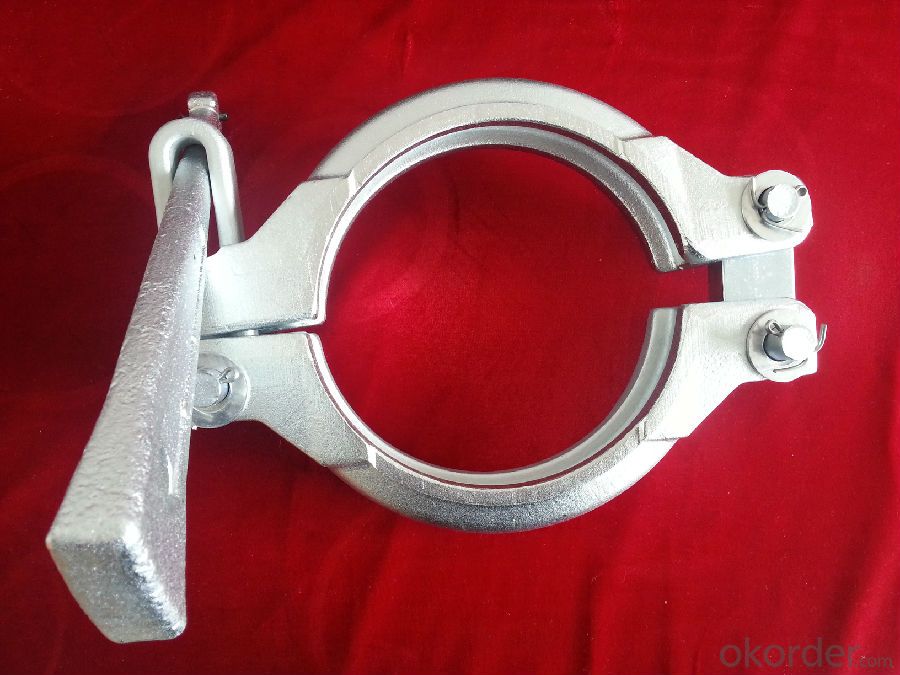
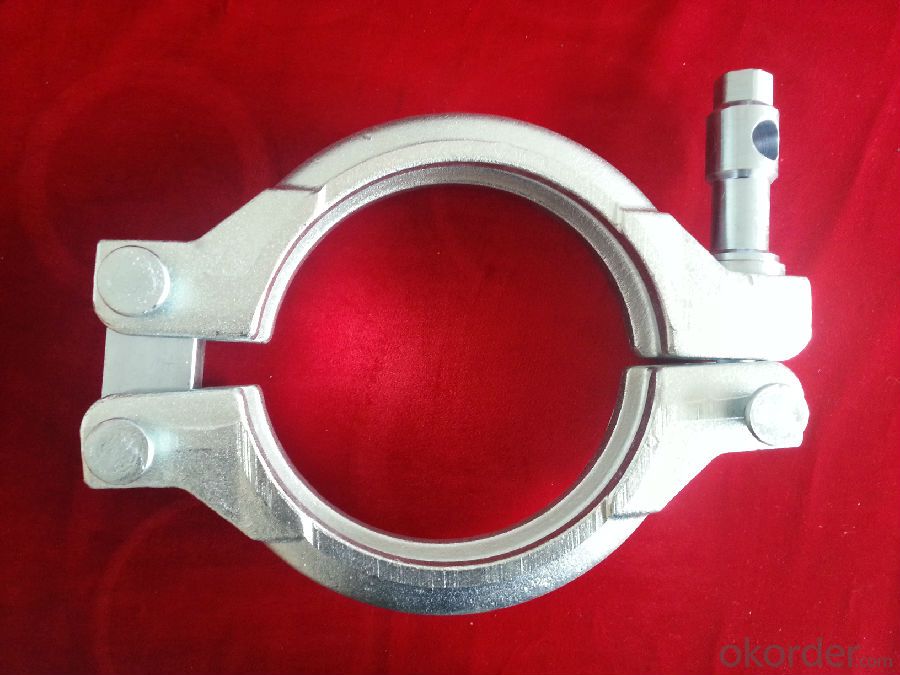
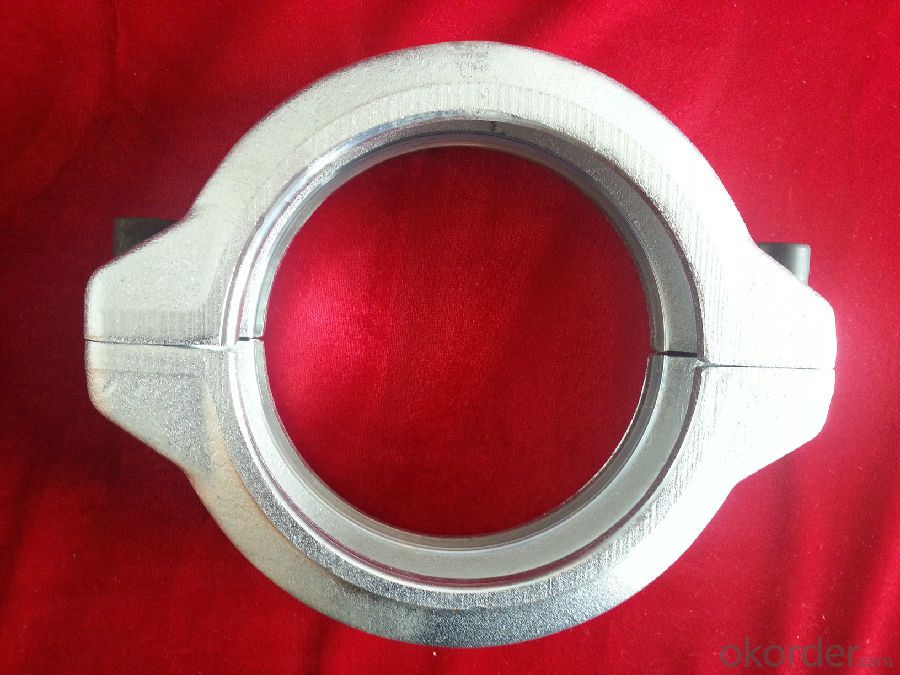

- Q:How do I properly maintain and replace hydraulic filters in concrete pump spare parts?
- To ensure your equipment's longevity and efficiency, it is crucial to properly maintain and replace hydraulic filters in concrete pump spare parts. Here are some guidelines to follow: 1. Familiarize yourself with the manufacturer's recommendations: Understand the maintenance and replacement guidelines provided by the manufacturer. These instructions may vary based on the specific pump model and filter type. 2. Regularly inspect the filters: Conduct regular inspections to identify any signs of damage, clogging, or excessive wear in the hydraulic filters. Look out for dirt, debris, or other contaminants that may hinder their performance. Address any issues promptly. 3. Establish a maintenance schedule: Implement a regular maintenance schedule for the hydraulic filters. This should include regular inspections, cleaning, and replacement intervals. Adhering to a schedule will prevent unexpected breakdowns and keep the concrete pump running smoothly. 4. Clean the filters: If the hydraulic filters can be cleaned and reused, ensure to follow the proper cleaning procedure. This typically involves removing the filter, washing it with a suitable cleaning solution, and allowing it to dry thoroughly before reinstalling. Take care not to damage the filter during the cleaning process. 5. Replace as necessary: Over time, hydraulic filters become less effective at filtering out contaminants. It is important to replace them according to the manufacturer's recommended intervals or sooner if they appear excessively dirty or damaged. Always use genuine spare parts to ensure compatibility and optimal performance. 6. Install correctly: When replacing hydraulic filters, ensure they are installed correctly and securely. Pay attention to any seals or gaskets that may need replacement as well. Improper installation can lead to leaks or reduced filtration efficiency. 7. Monitor performance: After replacing the hydraulic filters, closely monitor the pump's performance. Watch for changes in pressure, flow rate, or unusual noises. If any abnormalities are observed, it may indicate a problem with the filter or other components, requiring further investigation. By following these steps, you can effectively maintain and replace hydraulic filters in your concrete pump spare parts, ensuring optimal performance and extending the equipment's lifespan.
- Q:How often should hopper grate pins be inspected or replaced in a concrete pump?
- Hopper grate pins in a concrete pump should be inspected regularly, ideally before each use, to ensure they are in good condition. Depending on the frequency of usage and the material being pumped, replacement may be needed every few months or as soon as signs of wear and tear are observed.
- Q:What is the concrete delivery pump?
- Currently mainly divided into gate valve, concrete pump and S valve concrete pump
- Q:How often should hopper cylinders be inspected or replaced in a concrete pump?
- Hopper cylinders in a concrete pump should be inspected regularly to ensure optimal performance and prevent potential malfunctions. The frequency of inspections and replacements depends on several factors, including the intensity of usage, the type of concrete being pumped, and the overall condition of the equipment. As a general guideline, it is recommended to inspect hopper cylinders at least on a monthly basis or after every 100 hours of operation, whichever comes first. During these inspections, the cylinders should be thoroughly examined for any signs of wear, corrosion, or damage. Additionally, the seals, gaskets, and other components connected to the cylinders should be checked for proper functioning. However, it is important to note that the inspection frequency may need to be increased if the concrete being pumped contains abrasive materials or if the pump is being used in harsh environmental conditions. In such cases, more frequent inspections and replacements may be necessary to avoid unexpected breakdowns and costly repairs. Ultimately, the goal is to maintain the hopper cylinders in good condition and address any issues promptly. Regular inspections, along with routine maintenance and proper cleaning, can significantly prolong the lifespan of the cylinders and ensure the concrete pump operates efficiently and safely.
- Q:How often should the concrete pump wear plate be replaced?
- The frequency of replacing the concrete pump wear plate depends on several factors such as the type of concrete being pumped, the volume of concrete being pumped, and the operating conditions of the pump. Generally, wear plates are designed to withstand a certain amount of wear and tear before requiring replacement. In most cases, it is recommended to inspect the wear plate regularly to check for signs of excessive wear. This can include visible cracks, erosion, or a significant decrease in thickness. Regular visual inspections can help determine when it is time to replace the wear plate. Additionally, monitoring the pump's performance and efficiency can also provide insights into the wear and tear on the wear plate. If there is noticeable decrease in the pump's output or an increase in the required pumping pressure, it may indicate that the wear plate needs to be replaced. However, it is important to consult the manufacturer's guidelines and recommendations for your specific concrete pump model. They often provide recommendations on the expected lifespan of the wear plate and the intervals at which it should be replaced. Following these guidelines can help ensure optimal performance and longevity of your concrete pump.
- Q:What are the indications of a damaged concrete pump boom?
- The indications of a damaged concrete pump boom may include cracks or fractures in the boom structure, leaks in hydraulic lines, inconsistent or reduced pumping pressure, abnormal vibrations or shaking during operation, and difficulty in maneuvering or extending the boom arm.
- Q:Can concrete pump spare parts be painted or coated for increased durability?
- Yes, concrete pump spare parts can be painted or coated for increased durability. Painting or coating the spare parts can help protect them from corrosion, wear, and other forms of damage. By applying a layer of paint or coating, the spare parts can have improved resistance to harsh environmental conditions, chemicals, and moisture. Additionally, certain paints or coatings can offer additional benefits such as heat resistance or non-stick properties, which can further enhance the durability and performance of the spare parts. It is important to use appropriate paints or coatings that are specifically designed for the materials and conditions the spare parts will be exposed to, to ensure optimal adhesion and longevity.
- Q:What is the function of a concrete pump control lever?
- The concrete pump control lever serves the purpose of managing the concrete flow and direction during pumping. It grants the operator the ability to initiate or halt pumping, regulate the pump's speed, and govern the concrete's placement and speed of placement. Additionally, the control lever empowers the operator to transition between various pumping modes, such as vertical or horizontal pumping, and fine-tune the pressure of the pumped concrete. As a whole, the control lever plays a vital role in guaranteeing precise and efficient concrete pumping procedures.
- Q:How can a damaged concrete pump hopper affect the pumping process?
- A damaged concrete pump hopper can have several negative impacts on the pumping process. Firstly, a damaged hopper can lead to a decrease in efficiency and productivity. The hopper is responsible for holding and feeding the concrete mixture into the pump, and any damage to it can result in a disruption of the continuous flow of concrete. This can lead to frequent interruptions in the pumping process, causing delays and reducing the overall output of the pump. Secondly, a damaged hopper can affect the quality of the concrete being pumped. The hopper is designed to ensure proper mixing and consistency of the concrete mixture before it is pumped. If the hopper is damaged, it may not be able to effectively mix the concrete, leading to inconsistencies in the mixture. This can result in poor-quality concrete being pumped, which can compromise the structural integrity and durability of the final product. Moreover, a damaged hopper can pose safety risks for the workers involved in the pumping process. A damaged hopper may have sharp edges or loose parts that can cause injury if not properly addressed. Additionally, if the hopper is not functioning properly, it may lead to clogs or blockages in the pump, which can cause pressure build-up and potential accidents. Lastly, a damaged hopper can increase maintenance and repair costs. A hopper that is not in optimal condition may require frequent repairs or even replacement, which can be costly in terms of time and money. Regular maintenance and inspection of the hopper is crucial to identify any damages early on and prevent them from escalating into more significant issues. In conclusion, a damaged concrete pump hopper can significantly affect the pumping process by reducing efficiency, compromising the quality of the concrete, posing safety risks, and increasing maintenance costs. Regular inspection, maintenance, and timely repairs are essential to ensure the smooth operation of the pump and the delivery of high-quality concrete.
- Q:How often should concrete pump hydraulic motors be inspected and replaced?
- The frequency at which concrete pump hydraulic motors should be inspected and replaced depends on various factors such as the usage intensity, maintenance practices, and the specific manufacturer's guidelines. However, as a general rule of thumb, it is recommended to inspect hydraulic motors at least once every 6 to 12 months. This inspection should involve checking for any signs of wear and tear, leaks, or abnormal noises during operation. Regular maintenance, such as lubrication and cleaning, should also be performed as per the manufacturer's recommendations. Ultimately, the decision to replace hydraulic motors should be based on their condition and performance. If there are noticeable issues or a significant decrease in efficiency, it may be necessary to replace the hydraulic motors sooner than the suggested inspection interval.
1. Manufacturer Overview |
|
|---|---|
| Location | |
| Year Established | |
| Annual Output Value | |
| Main Markets | |
| Company Certifications | |
2. Manufacturer Certificates |
|
|---|---|
| a) Certification Name | |
| Range | |
| Reference | |
| Validity Period | |
3. Manufacturer Capability |
|
|---|---|
| a)Trade Capacity | |
| Nearest Port | |
| Export Percentage | |
| No.of Employees in Trade Department | |
| Language Spoken: | |
| b)Factory Information | |
| Factory Size: | |
| No. of Production Lines | |
| Contract Manufacturing | |
| Product Price Range | |
Send your message to us
Forged Wedge Coupling DN 125 with Hgh quality
- Loading Port:
- Tianjin
- Payment Terms:
- TT or LC
- Min Order Qty:
- 5 pc
- Supply Capability:
- 1000 pc/month
OKorder Service Pledge
OKorder Financial Service
Similar products
New products
Hot products
Hot Searches
Related keywords






